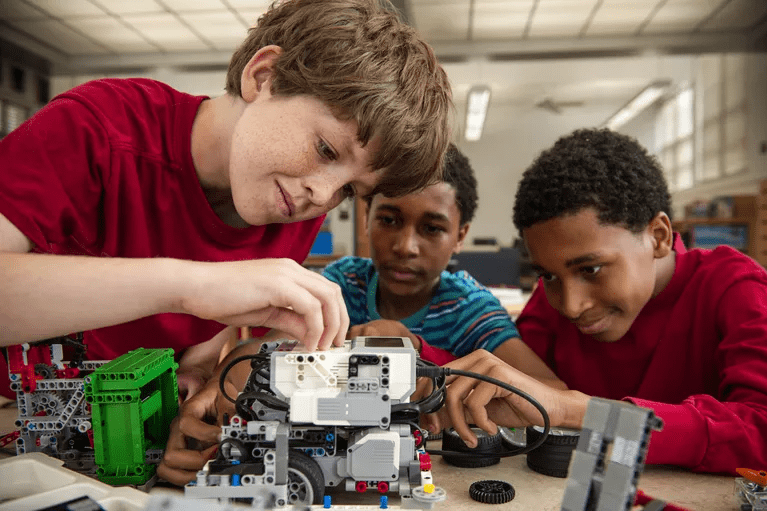Children with autism tend to love a few things very intensely. Play therapists have, for many years, built on autistic passions to help children learn skills such as collaboration, communication, and symbolic thinking. Now, a group of researchers finds that LEGO building toys are a particularly fruitful tool for autism therapy—and a great way to help autistic children build an interest they can share with their typical peers.
The Theory Behind Play Therapy
Maria Montessori said that “play is the work of childhood,” by which she meant that children learn through play. Neurotypical children use play to expand and better understand their world through experimentation, symbolic (imaginative) play, physical activity and sports, social interaction, and observation.
By pretending to be adults, television personalities, or superheroes, children practice using spoken language and behaving in expected ways. By playing organized games, children learn how to follow rules, collaborate with teammates, take turns, and work toward a shared goal.
Children with autism play very differently from their typical peers. They tend to play alone or engage in parallel play (two children doing the same thing, but each on his or her own).
While autistic children may memorize and recite lines or actions from movies or TV, they rarely expand on what they’ve learned with their own novel interpretations of characters or storylines.
And while autistic children may play games, they often have great difficulty with collaboration, turn taking, or working toward a shared goal.
In addition to playing differently, most children with autism have specific play patterns or routines that they repeat over and over again in identical ways.
For example, they may sing the same song from the same TV show in the same way with the same hand motions, over and over again. Or they may build and rebuild the same building from blocks, create the same train track layout, or run a toy car back and forth along the same path. When asked to try something new, they may become terribly upset because they find their repetitive play calming, while change can be anxiety provoking.
The many types of play therapy attempt to help autistic children to overcome challenges by building on existing interests to expand communication, imagination, and social skills. Rather than forbidding children to continue with their repetitive activities, play therapists use a variety of techniques to complicate and enhance their activities.
For example, if a child repetitively runs a truck over the same part of the carpet, a play therapist might place an obstacle on the carpet—thus requiring the child to negotiate the change and interact with the therapist. Through the process of play therapy, many therapists have seen significant improvement in language, communication, collaboration, and even physical skills.
Why LEGO Therapy Was Created
LEGO building toys are extraordinarily popular among autistic children.
They offer a simple, predictable, repeatable activity that can be accomplished alone without outside help. They are also part of a system of toys that look and behave in similar ways. LEGOs also offer the added bonuses of:
- Requiring strong fine motor skills and significant hand strength
- Requiring spatial, visual, and analytical skills
- Having intrinsic value in the wider world (LEGO play is universal, and LEGO models and structures have become well-recognized not only as toy models but also as art forms)
Upon noticing that many autistic children are already drawn to and love LEGOs, clinical neuropsychologist Dr. Daniel LeGoff started experimenting with LEGO therapy in 2003.
His idea was to create an effective social skills program that could be used in multiple settings and be transferable to real-world peer interactions. In 2004, he published a paper showing positive results from the program he created.
Today there are multiple practitioners as well as books and programs all focused on LEGO therapy. While there are a variety of behavioral and developmental approaches to the therapy, most use similar techniques for engaging children and requiring them to build skills in order to achieve their play-related goals.
How LEGO Therapy Works
The goal of LEGO therapy is to build the types of skills that can help autistic children better engage with peers, share experiences, and collaborate. This means that the children who are likely to benefit from LEGO therapy are already at least somewhat verbal and able to follow both visual and verbal instructions.
In the most basic form of LEGO therapy, children work in a group, taking the following roles:
- The Engineer – has a set of instructions for the model and has to request the bricks from the Supplier and direct the Builder to put the model together
- The Supplier – has the Lego bricks and supplies the Engineer with the required items upon request
- The Builder – is given the bricks by the Supplier and has to follow the instructions given by the Engineer to make the model.
An adult facilitator works with the group as needed to encourage problem-solving, communication, and engagement. In some cases, several therapists work together, using LEGOs to build motor skills, facilitate speech, and enhance social communication. Therapists involved with LEGO therapy may be occupational therapists, speech therapists, behavioral therapists, or even psychologists.
LEGO therapy can also be expanded to encourage creative play and collaboration through storytelling, dramatic activities, and innovation. For example, one version of LEGO therapy has children work together to build versions of a pretend world described in a story, or work together to create a vehicle that has specific qualities or can navigate in a particular situation.
Children can also work together to build much more elaborate LEGO Mindstorms robots and program them. In these more advanced scenarios, children collaborate in complex world-building, storytelling, or design.
Is LEGO Therapy Effective?
LEGO therapy is built around existing, effective, risk-free therapies. That means it can’t hurt and will likely help your child to build skills and possibly meaningful friendships built around common interests.
There are a limited number of studies focused on LEGO therapy, and most of those were conducted with small groups by individuals with a vested interest in seeing the therapy succeed.
No therapy is always successful for every child with autism, and much depends on the chemistry of a therapy group and its facilitator. In any therapeutic setting, some children will come away with improved skills while others won’t.
While the only thing you risk with LEGO therapy is time and money, you’re more likely to see positive outcomes if your child:
- Actively enjoys building models with LEGO
- Is more or less at the same functional level as the other children in the group
- Has the ability to follow verbal instruction
- Has shown at least some success in interactive play in the past
- Is able to change his or her set ideas without significant emotional upset
- Is motivated to build social relationships with peers
Before getting started with LEGO therapy, have a discussion with the therapist(s) to determine what their goals are, what the mix of children is like, and what their therapeutic approach includes. Have the therapist meet and evaluate your child to determine whether he or she is ready for this relatively advanced form of play therapy. If there is a question in your mind, you may want to ask that your child participates for a trial period.
What If My Child Doesn’t Like LEGOs?
There is nothing magical about LEGOs. In fact, the same therapeutic approach can work around any collaborative project that involves working together on a shared project toward a common goal.
Over the years, therapists have worked with autistic children using a wide range of activities, toys, and characters that tend to be interesting to people on the spectrum. While people on the spectrum don’t necessarily share the same fascinations, some common interests include:
- Thomas the Tank Engine
- fantasy games such as Dungeons and Dragons
- online collaborative games such as Minecraft
While it’s possible to build a therapy group around these or any other shared interest, however, it’s important that the group be properly structured and facilitated. It’s also important to conduct preliminary evaluations, set benchmarks, and continuously monitor the group to be sure that progress is being made.
LEGO Therapy Resources
LEGO therapy is not available everywhere, but most capable therapists who work with groups of autistic children are able to incorporate LEGO play into their programs. Parents can also learn to use LEGOs as a therapeutic tool in their own homes, working with siblings or other adults and children.
To learn more about LEGO therapy, you may want to speak with your school’s occupational or ABA therapist, speak with members of your local autism support group, or read one of these books:
- How LEGO®-Based Therapy for Autism Works: Landing on My Planet How LEGO®-Based Therapy for Autism Works: Landing on My Planet by Daniel B. LeGoff (founder of LEGO therapy)
- LEGO®-Based Therapy: How to build social competence through LEGO®-based Clubs for children with autism and related conditions by Simon Baron-Cohen.
Source: https://www.verywellhealth.com/


